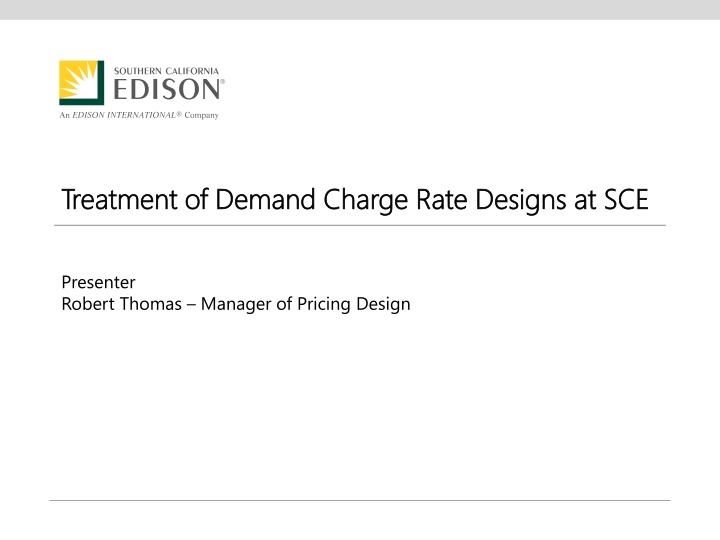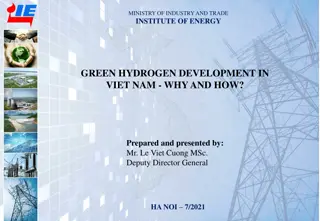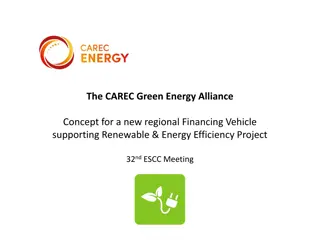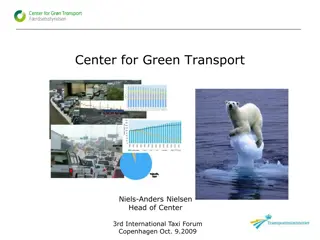Effective Rate Design Principles for Achieving California's Green Energy Goals
SCE is restructuring demand charge rates to achieve GHG reduction targets, focusing on fairness, efficiency, stability, and simplicity. Recent changes to legacy rate structures aim to recover costs and integrate Distribution Energy Resources efficiently.
Download Presentation

Please find below an Image/Link to download the presentation.
The content on the website is provided AS IS for your information and personal use only. It may not be sold, licensed, or shared on other websites without obtaining consent from the author.If you encounter any issues during the download, it is possible that the publisher has removed the file from their server.
You are allowed to download the files provided on this website for personal or commercial use, subject to the condition that they are used lawfully. All files are the property of their respective owners.
The content on the website is provided AS IS for your information and personal use only. It may not be sold, licensed, or shared on other websites without obtaining consent from the author.
E N D
Presentation Transcript
Treatment of Demand Charge Rate Designs at SCE Treatment of Demand Charge Rate Designs at SCE Presenter Robert Thomas Manager of Pricing Design
Rate Restructuring Requires a Balanced Approach SCE is committed to its Clean Power and Electrification Pathway as a means of achieving California s Greenhouse Gas (GHG) reduction goals A review and restructuring of legacy rate designs is a key element in achieving these goals Restructuring rates inevitably leads to redistribution of revenue recovery due to: Redefined cost basis (cost drivers) Reordering of structural benefiters Introduction of public policy driven rate designs GHG reductions should be achieved through a cost effective approach that also considers the impacts in such areas as: Affordability Building electrification Non-participant equity 1
Principles of Rate Design Rates should provide clear, efficient, effective, informative, and cost effective market Rates should provide clear, efficient, effective, informative, and cost effective market signals should allow the utilities to serve as an agent of progress. signals should allow the utilities to serve as an agent of progress. 1. Fairness Fairly apportion the cost of service among different customers (rates reflect cost causation) Avoid regressive rate structures/policies that favor participants over non- participants Efficiency Promote the efficient use of energy (and competing products and services) Support economic efficiency set prices to reflect marginal costs Stability Minimize unexpected rate changes that may be adverse to existing customers Ensure revenues (and cash flow) are stable from year-to-year Simplicity, understandability, public acceptability, and feasibility of application 2. 3. 4. SOURCE: EEI Publication, April 2013; Based on Principles of Public Utility Rates by James C. Bonbright, 1988 2
Recent Changes to SCEs Legacy Rate Structures - 2018 GRC Phase 2 SCE s 2018 General Rate Case (GRC) Phase 2 modified the legacy non- coincident peak (NCP) demand charge Distribution costs recovered through NCP demand charge include incremental capacity, reliability, and O&M spending associated with distribution grid infrastructure Customer marginal costs are recovered through fixed charges and consist of meter, service drop, and final line transformer 2018 GRC Phase 2 rates reflect new system conditions and facilitate the integration of Distribution Energy Resources (DERs) Two part Grid and Peak distribution cost recovery structure Grid components facilitate bi-directional flow of energy expected with DER applications Ensure appropriate cost recovery for cost components that are not time- or peak- dependent Time-dependent Peak component is associated with capacity growth and a pricing signal to reduce peak load conditions
SCE 2024 Forecast Average Hourly Peak Component of Distribution Design Demand Marginal Costs ($/kWh)* * Illustrative example 4
DER Rates Introduced in SCEs 2018 GRC Phase 2 Distribution Revenue Recovery Comparison SCE s 2018 GRC Phase 2 introduced Option E (a DER technology rate) Option E further reduced the amount of revenue recovered through NCP demand charges Provides a rate choice to recognize changing customer preferences Strikes a balance between: Customer choice Safeguards against revenue shifts Cost causation in rate design Equity across customer segments Revenues recovered through NCP demand charge are associated with the provision of bi- directional access of the grid Time variant energy and demand charges to recover revenues associated with peak capacity 5
Recent Changes to SCEs Legacy Rate Structure - Transportation Electrification (TE) Charging Rates Demand charge rate structures can result in higher average rates for low load factor early adopters Introduced a 5-year energy only introductory period Followed by a 5-year phase-in of demand charges End state TE rate structures envisioned to be consistent with Option E rate structure Load Management Plays a Key Role in Overall Benefit Gradually phasing in demand charges will allow customers to gain knowledge and experience regarding demand charges and load management still high on the Loading Order Rate Simplicity and Customer Understandability Rate design that does not require radical billing system changes Rate design that accommodates customer transitions from discounted to regular rate structure without disruption Rate equity provided by the transitory reduction in the policy driven benefit Demand charges gradually phased in to reflect the segment s contribution to grid costs 6
Average Rate Comparison - Illustrative TOU-EV-8/-9 vs. Standard Rates TE Rate Findings TE bill comparison is based on the current population, a vast majority served on this rate are DC fast charging customers Compared to Standard Option E, TOU-EV-8 provides about a 30% bill savings in the 5-year introductory period w/o demand charges, followed by an average bill savings of 17% in the subsequent years of the program. Compared to Standard Option D, TOU-EV-9 provides about a 24% bill savings in the 5-year introductory period w/o demand charges, followed by an average bill savings of 19% in the subsequent years of the program. Preliminary results with the daily demand charge rate indicate similar or greater differences to Options D & E Preliminary Daily Demand Charge Rate The Daily Demand Charge Option converts the NCP demand charge to a daily demand charge Retains time variant demand and energy charges associated with peak capacity Further analysis is needed to determine if the revenue shift constitutes a cost shift given bi-directional DERs use the grid even when providing electricity to the grid 7
Conclusion SCE has made considerable changes in NCP demand cost determination and rate design recognizing the benefits and costs associated with the changing energy landscape and new DER technologies Cost basis for the new rate structure must consider the bi- directional nature of DER technologies Equity across customer segments and affordability must be considered when introducing non-legacy rate structures Introduction of a newly structured cost based rate can redistribute revenue recovery across customer segments Has the potential to create division between those who can afford the new technologies and those who cannot Rate simplicity from a customer perspective and a billing system implementation perspective are critical to the successful adoption of non-legacy rate structures 8























